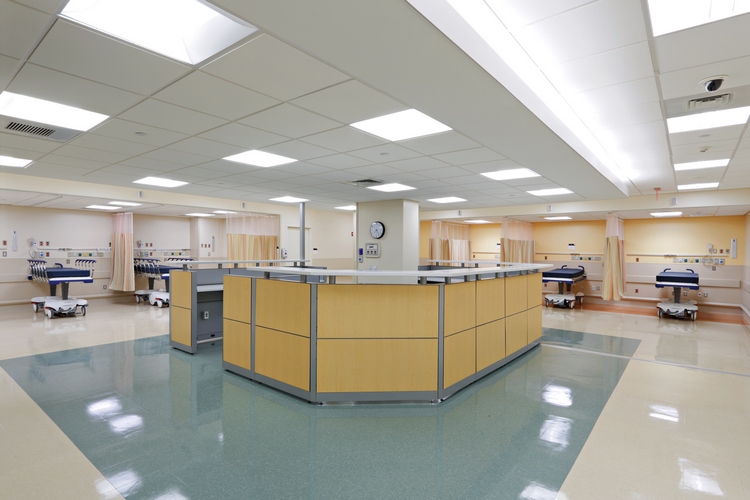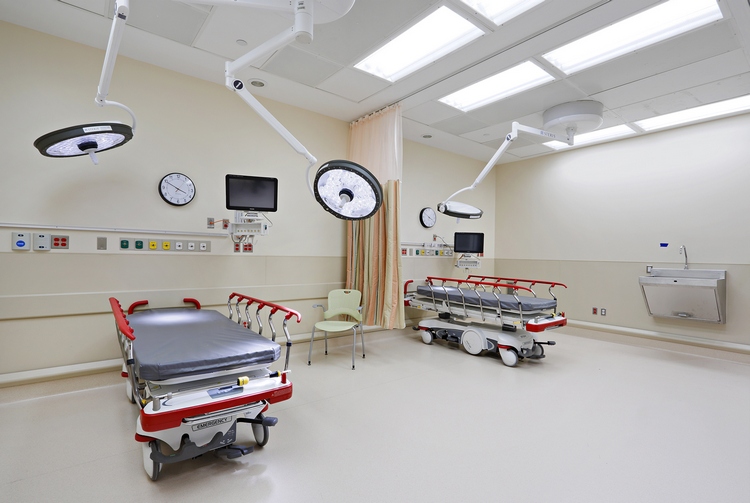Stalco Construction and Perkins Eastman Complete $24M Expansion, Renovation
BRONX, N.Y. — Representatives of the New York City Health and Hospitals Corporation and Generations+ Northern Manhattan Health Network, political and community leaders, general contractor Stalco Construction and architect Perkins Eastman celebrated the completion of an extensive expansion and renovation of Lincoln Medical Center Emergency Department. The emergency care facility and Level 1 trauma center is the fifth busiest ED in the United States and the busiest in New York City and the region.
New York State Senator José M. Serrano; Dr. Ram Raju, HHC president; Denise C. Soares, RN, senior vice president, Generations+/Northern Manhattan Health Network; Milton Nuñez, executive director, Lincoln Medical Center; Melissa Schori, M.D., chief medical officer, Lincoln Medical Center; Fernando Jara, M.D., chief of emergency medicine, Lincoln Medical Center; Keith Ward, Stalco Construction project manager and Perkins Eastman Principal Joseph Shein attended the ribbon cutting.
According to Stalco Principal Kevin G. Harney, “The $24-million expansion and renovation has resulted in an increase in the emergency department’s size to 57,905 square feet. The number of treatment bays has doubled from 53 to 106.”
Over the past 10 years, the communities the hospital serves saw a 15 percent increase in population. In 2013, patient visits totaled 177,778. The expanded ED will accommodate changing demographics, an increase in number of patients arriving from other sections of New York City and changing emergency treatment practices and regulatory requirements. In addition, the revised layout of pathways and corridors allows the hospital employees and visitors to easily navigate through the surrounding interiors without entering the ED.
The expansion and renovation created a dedicated children’s emergency unit, an adult waiting room, a new psychiatric and mental health emergency unit, a trauma center, an asthma patient unit and a women’s health section. The ED features a new, elegant ambulatory care entrance with a prominent glass canopy.
The project team included general contractor Stalco Construction; architect Perkins Eastman; construction manager Hunter Roberts; structural engineer GACE Consulting Engineers; mechanical, electrical and plumbing engineer Kallen & Lemelson, Consulting Engineers; geotechnical engineer Pillori Associates and landscape designer RGR Landscape.
Architecture
“The new pavilion acts as a beacon to patients and represents the hospital’s openness and inclusion, while attending to the need for additional space,” explained Joseph Shein, AIA, FACHA, Perkins Eastman principal.
The pavilion features a double-height glass curtain wall with an aluminum structural system, frosted glass in the lower sections for patient privacy and clear glass upper-clerestory windows. The roof is a single-ply EPDM membrane.
The new emergency entrance features an elaborate architectural glass and stainless steel canopy with a backlit emergency sign. The canopy is designed “upside down,” meaning the glass hangs from the support system rather than resting on top of it. The canopy features a cantilevered angled glass section suspended above the entrance. “We designed the custom canopy to serve as a focal point to the entrance,” said Perkins Eastman Associate Kenneth Easton, RA. “The canopy support system includes steel elements and stainless steel spider connections; the laminated clear glass is one-inch thick.”
The project incorporated the construction of a new circular front driveway with pavers and landscaping in front of the pavilion. This driveway serves patients and their families. It features a decorative compass rose element in its center, which symbolizes the varied ethnic backgrounds of patients served by the hospital, as well as patients coming from all sections of New York City. The drive is partially surrounded by decorative concrete traffic-control cones that light up at night and serve as security barriers in front of the ambulatory entrance.
Construction
“Closing down even part of the existing ED was out of the question,” said Stalco Project Manager Keith Ward. Work took part in three phases to ensure the emergency department, which operates 24/7/365, remained open and able to take in patients as usual.”
The first phase expanded the emergency room, making way for a new 1,900-square-foot waiting room. The 10,600-square-foot second phase, which took place concurrently with the first phase, was the renovation of existing spaces located in the north section of the ED. It houses the adult emergency unit, the asthma patient emergency unit and the behavioral health unit. The third phase, in the south section, was 7,500 square feet and houses the pediatric emergency unit, the trauma center and the women’s health unit. The 34,200-square-foot project also included construction of a new entrance lobby with automated doors and connecting corridors.
The building team carefully coordinated construction tasks and practiced strict environmental and noise control so as not to disturb the operating ED and the remainder of the hospital. The team worked with the hospital’s management to adopt stringent infection- and dust-control procedures, including protection of the HVAC ducts from contamination and the creation of air locks at the entrances and exits of construction areas. “Whenever construction activities might have created dust, Stalco used negative air pressure pumps to keep the dust within the construction zones and out of the working hospital areas,” said Vincent Marino, Stalco’s superintendent.
There were several instances when unforeseeable conditions arose that required quick response from the design and construction teams. These included discovering an abandoned glass tube-based chemical discharge system for the chemical X-ray lab behind a temporary wall. The team had to demolish it. In addition, a previously hidden material- and medication-distribution track suspended below the ceiling and a distribution station for the track system had to be removed to allow for the installation of the HVAC system and other utilities.
Further, two information technology rooms located in the existing space were originally planned to be moved. However, the hospital required them to remain in place, which necessitated layout revisions and careful construction work so as not to disrupt any of the servers or wiring.
Another challenge was encountered when it was time to connect the HVAC distribution system and the ductwork from the ground floor ED to the third-floor mechanical rooms. It required the use of X-ray scanners to map out embedded electrical and communication conduits prior to cutting openings in the concrete floor slabs.
The construction of the pavilion and expansion presented structural challenges. The existing exterior wall had to be opened in an area where the new pavilion was being built. The opening in the original exterior wall is 60 feet wide and 8 feet high. The team left three original steel columns encased in brick in place. Following cleaning and refurbishment, they now provide visual continuity from the exterior to the interior. he expansion also required a series of underground piles due to the low load-bearing capacity of the soil.
Interior Space
“One of the main ideas behind the new layout of the emergency department and its sections include the need for a clear flow of patient care from walk-in through triage to care area, depending on the patient type, such as children or adults,” continued Schein. At the same time, each interior module of care is connected to another to allow for “swing space” for the overflow assignment of patients when necessary.
The new facility includes the 1,900-square-foot waiting room pavilion, the adult emergency area, the pediatric section, the psychiatric and mental health unit, the trauma unit, the women’s health section, and the asthma patient unit. The interiors also feature a “Fast Track” urgent care treatment area, located in the new pavilion, that serves adults with non-emergency health issues.
The five new trauma rooms are each approximately 700 square feet. The regular treatment and exam rooms are approximately 200 square feet each. The treatment and trauma rooms feature medical systems, including oxygen, medical air and a vacuum. All patient bays and treatment rooms have head walls equipped with connections to medical systems.
“All exam and treatment rooms, as well as patient bays in each section, are positioned around centrally located nurse stations, “explained Shein. “This design solution provides clear views of all patient areas and accelerates the response time in case of an emergency.” Each of the five nurse stations within five sections of the ED and the main nurse management station feature counters, desks and storage cabinets and are equipped with multiple computers. The 30-foot-long main registration desk is U-shaped.
Ceilings in the trauma rooms are solid drywall with downlights and suspended surgery lights on movable arms installed on a prefabricated Unistrut structural steel support system that Stalco connected to the building’s structural steel frame. Elsewhere, the ceilings are acoustical tile with ceiling-mounted exam lights, although lighting in selected areas of the pediatric section is equipped with printed film covers that feature photographs of bright and colorful fish.
The flooring in the behavioral health section and trauma rooms is sealed sheet vinyl, and in most other areas it is vinyl composite tile (VCT). VCT is laid down in patterns to accentuate each area’s function, to provide wayfinding assistance, and to cheer up the space.
Posted April 9, 2014
More Articles:
- CxA Workshop & Exam
Apr 29, 2024 – Apr 30, 2024 - EMP Seminar & Exam at CxEnergy 2024
Apr 29, 2024 – Apr 30, 2024 - CxEnergy
Apr 29, 2024 – May 2, 2024 - PHCC West 2024
Apr 29, 2024 – May 2, 2024 - Lean in Design Forum 2024
May 1, 2024 – May 2, 2024 - IFMA’s Facility Fusion Conference & Expo
May 5, 2024 – May 7, 2024 - ASHE Academy 2024
May 6, 2024 – May 10, 2024













